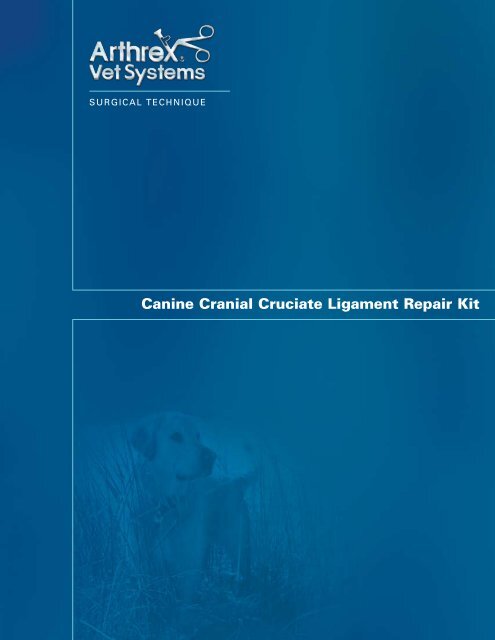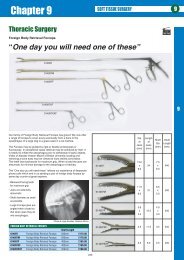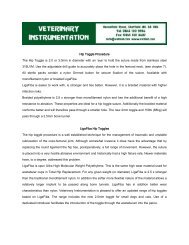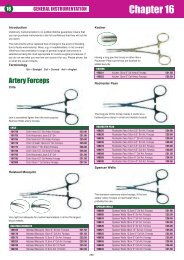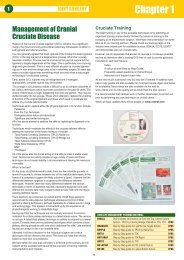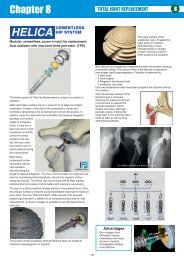Canine Cranial Cruciate Ligament Repair Kit - Veterinary ...
Canine Cranial Cruciate Ligament Repair Kit - Veterinary ...
Canine Cranial Cruciate Ligament Repair Kit - Veterinary ...
You also want an ePaper? Increase the reach of your titles
YUMPU automatically turns print PDFs into web optimized ePapers that Google loves.
SURGICAL TECHNIQUE<br />
<strong>Canine</strong> <strong>Cranial</strong> <strong>Cruciate</strong> <strong>Ligament</strong> <strong>Repair</strong> <strong>Kit</strong>
Surgical Technique<br />
The patient is positioned in lateral or dorsal recumbency under general anesthetic.<br />
A hanging limb technique with aseptic preparation and appropriate draping should<br />
be performed.<br />
A lateral parapatellar approach with arthrotomy is performed and complete exploration<br />
of the stifle joint is completed. Pathologic ligament and meniscus should be treated<br />
appropriately. The joint is thoroughly lavaged and the joint capsule closed.<br />
Developed in conjunction with<br />
James L. Cook, DVM, PhD, at<br />
Comparative Orthopaedic Laboratory,<br />
University of Missouri,<br />
Columbia, Missouri.<br />
1 2<br />
After the joint capsule is closed,<br />
a combination of sharp and blunt<br />
dissection is used to separate the<br />
vastus lateralis and biceps femoris<br />
muscles and retract the biceps<br />
caudally (Senn retractor) to allow<br />
for exposure and palpation of the<br />
lateral fabella (pin pointing to it).<br />
The curved needle on the <strong>Canine</strong><br />
<strong>Cruciate</strong> Suture is then placed with<br />
the tip on the midpoint of the lateral<br />
fabella and “walked” proximally until<br />
it can be inserted between the fabella<br />
and femur and passed completely<br />
around the fabella from proximal<br />
to distal.
3 4 5<br />
It is important to make sure the<br />
needle is around the fabella and<br />
not caudal to it. This can be verified<br />
after suture placement by pulling<br />
on both strands of the suture to<br />
ensure they are around the bone<br />
of the fabella and not soft tissues<br />
caudal to it. It is also important to<br />
minimize the amount of soft tissue<br />
encompassed in the suture throw,<br />
paying particular attention to the<br />
peroneal nerve distally. The curved<br />
needle on the <strong>Canine</strong> <strong>Cruciate</strong><br />
Suture is designed to help promote<br />
correct placement.<br />
The straight needle on the<br />
<strong>Canine</strong> <strong>Cruciate</strong> Suture is passed<br />
deep to the patellar ligament<br />
from lateral to medial at the most<br />
distal point possible. The suture<br />
should be caudal to the ligament<br />
and cranial to the fat pad.<br />
A 2-3 mm hole is drilled in the<br />
proximal tibia using a pin and<br />
Jacob’s chuck or drill bit and drill.<br />
The location of the hole should<br />
be immediately distal to Gerdy’s<br />
tubercle and immediately proximal<br />
to the point of origin of the cranial<br />
tibial muscle. The hole should<br />
be slightly angled caudoproximal<br />
to craniodistal to match the final<br />
direction of the suture.<br />
6<br />
7 8<br />
As the pin or drill is removed,<br />
the straight needle on the <strong>Canine</strong><br />
<strong>Cruciate</strong> Suture is inserted in the<br />
tibial hole from medial to lateral,<br />
and the suture is advanced to<br />
allow for easy tying.<br />
Both needles are cut off of the<br />
<strong>Canine</strong> <strong>Cruciate</strong> Suture and<br />
the suture is tied at the desired<br />
tension so as to prevent abnormal<br />
cranial drawer and internal<br />
rotation. The stifle is then put<br />
through a range of motion to<br />
ensure the suture has been placed<br />
correctly and is not impinging<br />
on periarticular structures. The<br />
area is lavaged.<br />
The lateral fascia is closed with<br />
the imbricating pattern of choice.<br />
Routine subcutaneous tissue and<br />
skin closures are performed.<br />
Postoperatively, the patient is<br />
typically bandaged for a minimum<br />
of 24 hours. Exercise restriction<br />
with controlled physical rehabilitation<br />
is recommended through<br />
12 weeks after surgery.
Revolutionizing<br />
Orthopaedic Surgery<br />
FiberWire suture is constructed of a muti-stranded<br />
long chain ultra-high molecular weight polyethylene<br />
core with a polyester braided jacket that gives<br />
FiberWire superior strength, soft feel and abrasion<br />
resistance that is unequaled in orthopaedic surgery.<br />
Suture breakage during knot tying is virtually<br />
eliminated, especially critical during arthroscopic<br />
procedures. FiberWire represents a major advancement<br />
in orthopaedic surgery.<br />
Strength<br />
FiberWire has greater strength than comparable size<br />
standard polyester suture. Multiple independent<br />
scientific studies document significant increases<br />
in strength to failure, stiffness, knot strength and<br />
knot slippage with much less elongation 1 .<br />
Tie Ability and Knot Profile<br />
Superior strength allows tighter loop security<br />
during knot tying, increasing knot integrity while<br />
reducing the knot profile compared to standard<br />
polyester suture.<br />
Abrasion Resistance<br />
The multi-strand long chain ultra-high molecular<br />
weight polyethylene core dramatically increases<br />
FiberWire abrasion resistance. Surgical procedures<br />
that create bone edges, tunnel edges, and articulating<br />
surface abrasion areas are appropriate indications for<br />
FiberWire. FiberWire is over five times more abrasion<br />
resistant than standard polyester suture.<br />
Safety in Numbers<br />
Trusted by leading orthopedic surgeons<br />
worldwide since its introduction in 2002,<br />
FiberWire has contributed to successful surgical<br />
outcomes in over one million orthopaedic<br />
surgical procedures. Extensive biocompatibility,<br />
animal and clinical testing prove that FiberWire<br />
demonstrates biocompatibility characteristics<br />
equivalent to standard polyester suture.
FiberWire Tensioner<br />
The FiberWire Tensioner provides controlled<br />
tensioning option of FiberWire loops during knot<br />
tying. When reapproximating soft tissue, the blunt<br />
tip keeps the knot in place while the tensioning<br />
wheel and spring mechanism gently tension the<br />
loop to tighten the repair.<br />
The tensioning wheel is then turned in a counterclockwise<br />
fashion as the tension meter is read. Once<br />
the desired amount of tension/reduction is achieved,<br />
three reverse half-hitches can be thrown down the<br />
barrel of the tensioner to secure the<br />
fixation.<br />
FiberWire Scissor<br />
The FiberWire Scissor was designed to cut any size<br />
or style suture, especially FiberWire, in open surgical<br />
cases where an arthroscopic suture cutter is not<br />
necessary. With its specially designed cutting<br />
edges, it can cut FiberWire cleanly and<br />
effortlessly without frayed edges.<br />
ORDERING INFORMATION<br />
<strong>Canine</strong> <strong>Cruciate</strong> Suture<br />
FiberWire Tensioner<br />
FiberWire Scissor<br />
VAR-2000<br />
AR-1929<br />
AR-11796<br />
References:<br />
1<br />
Burkhart SS. Arthroscopic Knots: The Optimal Balance of Loop Security<br />
and Knot Security. Arthroscopy 2004; 20.
Arthrex Vet Systems<br />
27299 Riverview Center Boulevard, Suite 108, Bonita Springs, Florida 34134-4322 • USA<br />
Tel: 888-215-3740 • Fax: 877-454-4352 • Website: www.arthrexbiosystems.com<br />
Arthrex GmbH<br />
Liebigstrasse 13, D-85757 Karlsfeld/München • Germany<br />
Tel: +49-8131-59570 • Fax: +49-8131-5957-565<br />
Arthrex Latin América<br />
3750 NW 87th Avenue, Suite 620, Miami, Florida 33178 • USA<br />
Tel: 954-447-6815 • Fax: 954-447-6814<br />
Arthrex S.A.S.<br />
5 Avenue Pierre et Marie Curie, 59260 Lezennes • France<br />
Tel: +33-3-20-05-72-72 • Fax: +33-3-20-05-72-70<br />
Arthrex Canada<br />
Lasswell Medical Co., Ltd., 405 Industrial Drive, Unit 21, Milton, Ontario • Canada L9T 5B1<br />
Tel: 905-876-4604 • Fax: 905-876-1004 • Toll-Free: 1-800-224-0302<br />
Arthrex GesmbH<br />
Triesterstrasse 10/1 • 2351 Wiener Neudorf • Austria<br />
Tel: +43-2236-89-33-50-0 • Fax: +43-2236-89-33-50-10<br />
Arthrex BvbA<br />
Technologiepark Satenrozen, Satenrozen 1a, 2550 Kontich • Belgium<br />
Tel: +32-3-2169199 • Fax: +32-3-2162059<br />
Arthrex Ltd.<br />
Unit 16, President Buildings, Savile Street East, Sheffield S4 7UQ • England<br />
Tel: +44-114-2767788 • Fax: +44-114-2767744<br />
Arthrex Hellas - Medical Instruments SA<br />
43, Argous Str. - N. Kifissia, 145 64 Athens • Greece<br />
Tel: +30-210-8079980 • Fax: +30-210-8000379<br />
Arthrex Sverige AB<br />
Turbinvägen 9, 131 60 Nacka • Sweden<br />
Tel: +46-8-556 744 40 • Fax: +46-8-556 744 41<br />
Arthrex Korea<br />
Rosedale Building #1904, 724 Sooseo-dong, Gangnam-gu, Seoul 135-744 • Korea<br />
Tel: +82-2-3413-3033 • Fax: +82-2-3413-3035<br />
Arthrex Mexico, S.A. de C.V.<br />
Insurgentes Sur 600 Mezanine, Col. Del Valle Mexico D.F. • Mexico<br />
Tel: +52-55-91722820 • Fax: +52-55-56-87-64-72<br />
This description of technique is provided as an educational tool and clinical aid to assist properly licensed medical professionals<br />
in the usage of specific Arthrex products. As part of this professional usage, the medical professional must use<br />
their professional judgment in making any final determinations in product usage and technique.<br />
In doing so, the medical professional should rely on their own training and experience and should conduct<br />
a thorough review of pertinent medical literature and the product’s Directions For Use.<br />
© Copyright Arthrex Vet Systems, 2006. All rights reserved. VLT0002A<br />
U.S. PATENT NOS. 6,716,234 and PATENT PENDING<br />
#VLT0002#


